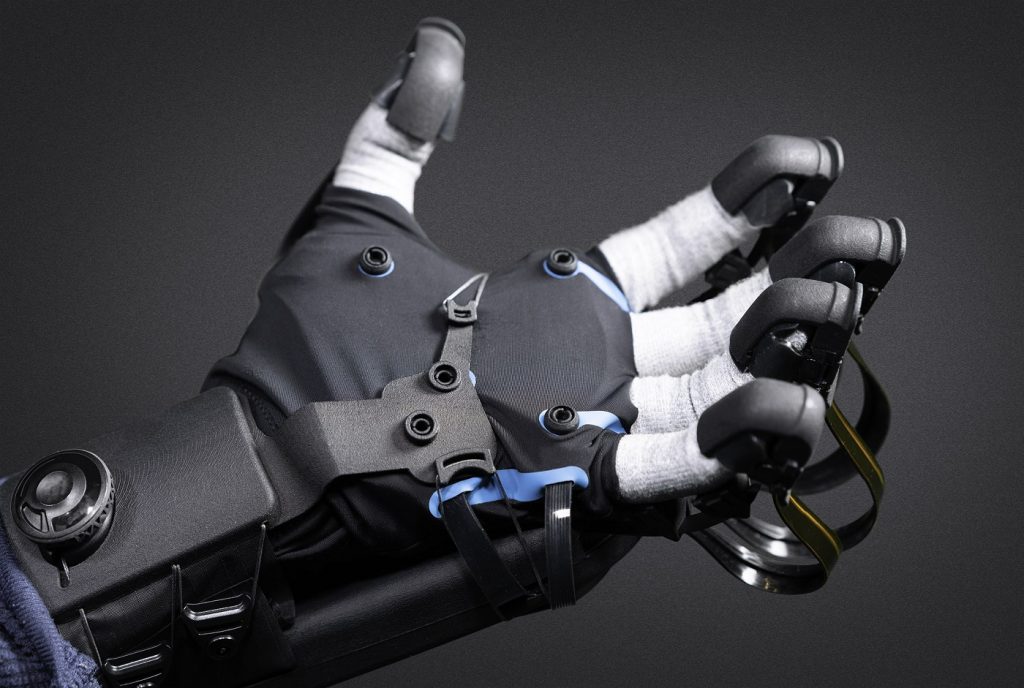If you’re older — older than your early twenties — you probably remember when DualShock came out. Though developed by Sony around twenty years ago, DualShock is still in use today. It’s a system that uses a small motor to spin weights in a controller. You feel it when you rev your motor, get shot, or do any number of things in a video game. It’s a simple form of haptics — interacting through touch. DualShock brings your attention to things but it doesn’t let you experience them.
Today, VR technology lets you hear what’s going on around you as if you were there. You can turn your head and look around. However, haptics haven’t really evolved a whole lot from the DualShock system. HaptX is looking to change that.
What Is HaptX?
HaptX is a small, west coast-based VR technology company that’s doing some pretty big things. They make gloves that provide realistic sensory stimulation. We’re not talking about a vibration coming from a controller any time that you do anything. We’re talking about feeling an object with your finger tips, or feelings resistance when you act against it. You can even feel weight and texture, according to the company’s website.

The Tech That You Know
Some of the VR technology behind HaptX gloves isn’t that new in terms of VR. The tracking software at the core of their gloves is similar to the one other VR and non-VR applications use. They have had to develop their own advanced software to make it apply to gloves, however. After all, your fingers have a lot more freedom of motion than your head and your hand. Also, you’ve got a lot more fingers than you have heads or hands.
Similarly, in order for the gloves to work, you need a 3D model of the objects. The software that is used to create those models is powered by familiar names like Unreal Engine and Unity. HaptX doesn’t only use this VR technology because it is available. Using familiar software systems makes it easier for developers to use HaptX. It also means that existing models can more easily be used with it.
The Tech That You Don’t Know
That doesn’t mean that the VR technology behind HaptX is unoriginal. Every new innovation is built on what came before it. Where the company really makes waves is with its actual haptics — the systems that let you feel virtual objects and forces. This has to do with the physical forces acting on the user.
As mentioned above, most modern haptics work with small motors. The HaptX system works with pneumatics — that is, the force of fluids or, in this case, air.

Two key components of the HaptX glove are the skin and the skeleton. The skin of the glove is made with “microfluidic actuators”. It’s a system that is both insanely complicated and beautifully simple. These activators are small air pockets with controllable pressure. Each glove has 130 of these pockets making for a texture kind of like very fine bubble wrap. When you encounter a virtual object, pressure in these actuators change simulating contact with a physical object.
Most of the size of the glove comes from the skeleton. The skeleton uses a series of tubes connected to a mini compressor. This allows the hand and each finger to feel weight and resistance.
How Would You Use HaptX?
So, what might VR technology like this be used for? There’s hope for a more widely available model of the HaptX glove for gaming — and the company isn’t against that idea. However, most of their applications so far are far more practical.
While most of us encounter VR technology through gaming, it also has its place in various other industries, such as design and training simulations. That’s primarily where HaptX is used so far, particularly in automotive design and the training of emergency responders.
There is also a page on the company website where they hint at the eventual creation of a HaptX suit. It might function a bit like the HoloSuit that some of us are looking forward to. It might be developed sooner but look and work a whole lot differently.




